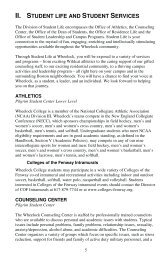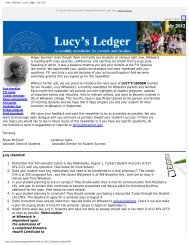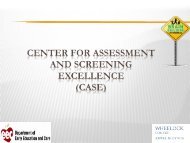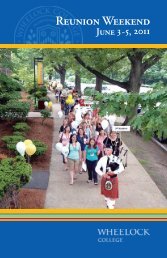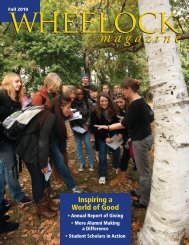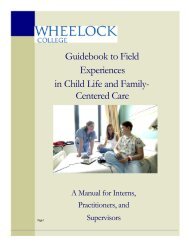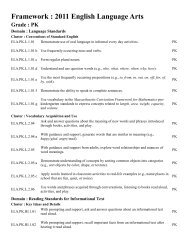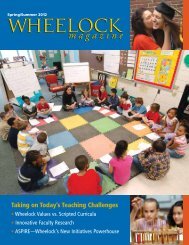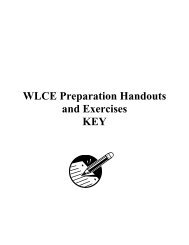Download the study (pdf)
Download the study (pdf)
Download the study (pdf)
You also want an ePaper? Increase the reach of your titles
YUMPU automatically turns print PDFs into web optimized ePapers that Google loves.
ReferencesAmerican Psychological Association (2007). The psychological needs of U.S. military servicemembers and <strong>the</strong>ir families: A preliminary report. Presidential Task Force on MilitaryDeployment Services for Youth, Families and Service Members.Anderman, L. H., & Leake, V. S. (2005). The ABCs of motivation: An alternative framework forteaching preservice teachers about motivation. Clearing House: A Journal of EducationalStrategies, Issues and Ideas, 78(5), 192.Bol, L., Nunnery, J.A., & Low<strong>the</strong>r, D. (1998). Inside-in and outside-in support for restructuring: <strong>the</strong>effects of internal and external support on change in <strong>the</strong> New American Schools. Education andUrban Society 30 (3),358-384.Brooks, D. W., & Shell, D. F. (2006). Working memory, motivation, and teacherinitiatedlearning. Journal of Science Education and Technology, 15(1), 17-30.Blum, R. (2005). School connectedness: Improving <strong>the</strong> lives of students. Military Child Initiative.Baltimore, MD: Johns Hopkins Bloomberg School of Public Health.Bradshaw, C., Sudhinarase, M., Mmari, K., & Blum, R. (2010). School transitions among militaryadolescents: A qualitative <strong>study</strong> of stress and coping. School Psychology Review, 39(1), 84-105.Chandra, C., Lara-Cinisomo, S., Jaycox, L., Tanielian, T., Burns, R., Ruder, T., & Han, B.(2009). Children on <strong>the</strong> homefront: The experience of children from military families.Pediatrics, 125, 16-26.Collins, R. (n.d.). Five things school leaders can do to promote academics. Retrieved fromhttps://www.aasa.org/content.aspx?id=9012Delbecq, A. & Van de Ven, A. (1971). A group process model for problem identification and program planning.The Journal of Applied Behavioral Science, 7(4), 466-492.Denham, S. & Brown, C. (2010). “Plays nice with o<strong>the</strong>rs”: Social-emotional learning and academicsuccess. Early Education and Development, 21(5), 652-680.Engel, R. C., Gallagher, L.B. & Lyle, D.S. (2006). Military deployments and children’s academicachievement: Evidencefrom Department of Defense Education Activity Schools. Retrievedfrom http://s3.documentcloud.org/documents/205139/deployments-and-dodea.<strong>pdf</strong>Gewirtz, A., Polusny, M., Erbes, C., & Forgatch, M. (2011). Helping military families through <strong>the</strong>deployment process: Strategies to support parenting. Professional Psychology:Research andPractice, 42(1), 56-62.Glaser, B.G. & Strauss, A.L. (1967). The Discovery of Grounded Theory: Strategies for QualitativeResearch. Chicago, IL: Aldine Publishing Company.Hogan, M., Parker, J., Wiener, J., Watters, C., Wood, L. & Oke, A. (2010). Academic success inadolescence: Relationships among verbal IQ, social support and emotional intelligence. Journal ofPsychology, 62(1), 30-41.Huebner, A., Alidoosti, B., Brickel, M., & Wade, K.(2010). Military family needs assessment: Finalreport, 1-53.Keegan, D., Hyle, A., Sanders, V. (2004). Cultural competence, educators, and military families:Understanding <strong>the</strong> military in a department of defense dependents school. Journal of SchoolLeadership, 14, 600-621.Kelley, M., Herzog-Simmer, P., & Harris, M. (1994). Effects of military-induced separation on <strong>the</strong>parenting stress and family functioning of deploying mo<strong>the</strong>rs. Military Psychology, 6(25), 125-138.McNeely, C., Nonnemaker, J., & Blum, R. (2002). Promoting school connectedness: Evidence from <strong>the</strong>national longitudinal <strong>study</strong> of adolescent health. Journal of School Health 72(4), 138-146.21



